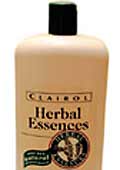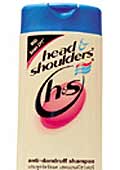|
 Even
while India Household and Healthcare Limited (IHHL), the Chennai-based
sole franchisee of LG Care fast moving consumer goods (FMCG) in
India rolls out LG's soaps, toothpaste, shampoos, diapers and hairstylers
across four lakh retail outlets in the country, it is looking hard
to find answers to the impasse that has gripped not just the Rs
47,800-crore FMCG market but even the hitherto robust Rs 12,088-crore
personal care market in the country. Even
while India Household and Healthcare Limited (IHHL), the Chennai-based
sole franchisee of LG Care fast moving consumer goods (FMCG) in
India rolls out LG's soaps, toothpaste, shampoos, diapers and hairstylers
across four lakh retail outlets in the country, it is looking hard
to find answers to the impasse that has gripped not just the Rs
47,800-crore FMCG market but even the hitherto robust Rs 12,088-crore
personal care market in the country.
"What is killing the personal care market
in this country is the sachet," says Vijay Singh, Managing
Director, IHHL. Perhaps what he is saying is right, for, how else
does one explain the findings of a recent ACNielsen Global Services
study on 58 personal care product categories held across 56 countries?
The study, What's Hot Around The Globe: Insights On Growth In Personal
Care, places the growth in sales of these products in India right
at the bottom of the global heap-at a negative 0.2 per cent-even
while the whole of Asia Pacific registered a growth of 1 per cent,
and Europe, a developed market, 4 per cent on a huge $ 40 billion-plus
base.
Emerging markets such as Russia, the Czech Republic
and Poland saw a strong double-digit 13 per cent growth, with Latin
America touching 10 per cent. "Nowhere in the world is the
sachet, which is merely a sampler, sold at a price. Our research
showed that in the long run, marketers lose almost half a bottle
of shampoo consumption per month per household because of the sachet,"
adds IHHL's Singh.
Little wonder then that while shampoo sales
grew 4 per cent globally, it declined 3.1 per cent in India last
year. The biggest of all players in the Indian shampoo market, the
Rs 10,138-crore Hindustan Lever Ltd., sold nearly 450 crore units
of shampoo sachets in 2003. Is there a huge opportunity cost to
that? Sachets, in a sense, have eroded the product availability
at consumer homes, because the single use-and-throw packs have pushed
the traditional bottle out. Globally, the trend is just the reverse-bigger
consumer packs drive volumes and value growth. For instance, Procter
& Gamble's recently-launched five ounce jars of facial cream
retail for over $100 in the United States.
India also went against the global, and even
the Asia Pacific market trends in many more personal product categories.
Take male grooming products, for instance. The global trend shows
the grooming-aware metro-sexual man pushing growth in not just male-oriented
categories like deodorants, shaving systems and shaving creams,
but even in unisex products like shower gels and hairstylers. Cut
to India, and what you have is blood all over these categories-barring
the basic products, razors and blades-with growth even in these
managing to just about touch 2 per cent in 2003, even while the
market grew at around 5 per cent globally.
 "A
large part of the cologne and perfume market is gray in India, and
therefore does not reflect in retail sales data," explains
Anmol Sherpa, Senior Manager and Client Service and International
Service Coordinator for ACNielsen Global Services. While that may
well be true, how does one explain negative growth in well-represented
retail audit categories such as toothpastes and toilet soaps? "A
large part of the cologne and perfume market is gray in India, and
therefore does not reflect in retail sales data," explains
Anmol Sherpa, Senior Manager and Client Service and International
Service Coordinator for ACNielsen Global Services. While that may
well be true, how does one explain negative growth in well-represented
retail audit categories such as toothpastes and toilet soaps?
In a country of over a billion people with
a population growth rate of 1.9 per cent annually, one could expect
basic hygiene considerations to take soaps and toothpaste sales
up, much like the 3 per cent-plus growth globally.
Yet, the Rs 2,000-crore toothpaste market fell
over 8 per cent in 2003, and this, when nearly two-thirds of the
56 countries surveyed showed positive growth in toothpaste sales.
In fact, tooth-stain removers and whiteners was the fastest-growing
category across the globe at a scorching 48 per cent, adding $127
million (Rs 584 crore) to its already high $15-billion (Rs 69,000
crore) dental care market. Even toilet soaps grew by over 10 per
cent in most Asian countries last year due to the threat of Severe
Acute Respiratory Syndrome (SARS), while the Rs 4,800-crore Indian
toilet soaps market declined by around 6 per cent in 2003.
Female vanity too suffered a setback in India,
much like everywhere else this time, with declining sales being
the trend across most categories including nail polishes, perfumes
and colognes. India managed to duck the declining lipstick sales
though, while the sale of face cleansers slid here as against a
7 per cent growth worldwide.
 |
| While shampoo sales grew by around 4 per
cent globally, it declined by 3.1 per cent in India last year |
Fortunately, this declining sales trend in personal
products in India is not secular with smart marketers using product
innovation to drive growth. "We identified shower gels and
liquid hand washes as emerging categories where consumers seek to
upgrade to products that do more than just cleanse and moisturise,"
says Vinay Hegde, Vice President (Marketing), Colgate-Palmolive
India. Over the past year, since its launch in India, Palmolive
Aroma shower gels have experienced a strong double-digit growth
of over 25 per cent.
Though it is still too early to pass the verdict,
the experience of Colgate-Palmolive in India does point to a clear
switch from bar toilet soaps to shower gels, albeit only with very
high-income consumers at the moment.
Another case in point is Hindustan Lever. Even
while it barley managed to grow its overall sales in 2003, its 12-brand
personal product portfolio grew by over 15 per cent-from Rs 2,095-crore
in 2002 to Rs 2,410-crore in 2003. Expanding its skin-care brand
Fair & Lovely to include newer usages such as anti-marks and
deep-skin variants helped HLL double the brand's sales in just three
years. Little wonder then, that the anti-spot and acne cleansers
category grew at a strong 18 per cent in India, almost thrice the
global rate in 2003 and is inviting a lot of activity. "We're
extending our fairness cream, Fairever, to the ayurvedic platform,"
says C.K. Ranganathan, Chairman of the Rs 300-crore personal products
company, KavinCare.
 |
 |
 |
| Though India was consistent with
the global theme of innovation, the level of market stimulation
remained uniquely Indian |
Another bright spot for India is the hair care
category, barring shampoos. The hair conditioners category with
brands such as L'Oreal's Ultra Doux, Modi Revlon's Flex and Hindustan
Lever's Sunsilk, is growing a phenomenal 50 per cent, though the
category comprises a mere 1 per cent of the entire hair care market.
Hair colourants, with a fourth of the hair care pie, is also growing
at a healthy 6 per cent. "Hair colourants are driving the growth
of conditioners," adds ACNielsen's Sherpa.
Though India was consistent with the global
themes of innovation, convenience and concern for health and safety,
the level of market stimulation or inhibition remained uniquely
Indian. So while in Indonesia, a market similar to India in more
than one way, the disposable baby diapers segment grew by a phenomenal
24 per cent, it just inched up 1.2 per cent in India, not reflecting,
in any way, our young demographics.
On the other hand, the female hygiene category,
in particular, the market for sanitary napkins, exploded with the
introduction of low-priced products, registering 11 per cent growth
across the country and an eye-popping 24 per cent in the rural markets.
COLUMN/JANE PERRIN
Males Make Their Mark |
 An
increased interest in appearance, hygiene and grooming on the
part of today's males has contributed to the growth in personal
care categories around the world. A look at the ACNielsen Global
Services study, What's Hot Around the Globe: Insights on Growth
in Personal Care, which analysed retail purchases in 56 countries
across 58 categories, found many examples of this trend. An
increased interest in appearance, hygiene and grooming on the
part of today's males has contributed to the growth in personal
care categories around the world. A look at the ACNielsen Global
Services study, What's Hot Around the Globe: Insights on Growth
in Personal Care, which analysed retail purchases in 56 countries
across 58 categories, found many examples of this trend.
Women aren't the only ones focused on personal grooming.
In many of the countries we studied, the growth in personal
care categories was impacted by the introduction of new male-oriented
products. In the UK, for instance, the shower gel category
grew by a mere 4 per cent last year, while the male segment
grew by 18 per cent.
Two other categories, deodorants and razors and blades,
are also benefiting from the men's newfound attention to appearance.
Moving in tandem, the deodourants category grew by 5 per cent
overall, with 35 of the 50 countries studied by ACNielsen
reporting an increase and the sales of male-oriented products
grew twice as fast as that of female-oriented products.
Our study also found the trend towards older populations
affecting purchases in the personal care arena. With the baby
boomer segment getting older and continuing to influence the
consumer marketplace, the sale of anti-aging products is growing.
Face & eye moisturisers grew by 10 per cent with the introduction
of creams that do everything from reducing wrinkles and minimising
dark circles to lightening age-spots.
Consumers' desire for convenience, a key global trend found
in other ACNielsen studies, was also seen across a number
of categories within personal care. For example, new baby
care products that emphasised on convenience, performed well.
Disposable diaper pants are being used as an easier way to
change a baby on the go and not just as a training tool. Developing
economies in Latin America, parts of Asia, Eastern Europe,
the Middle East and Africa experienced the fastest growth,
with a number of categories expanding by double digits, while
the more developed economies reported slower growth. While
looking at global trends, it is important to consider the
fact that what is new in one country may well have been available
for years in another. Disposable diapers, for example, grew
by 24 per cent in Indonesia as the dimensions of the category
expanded with the introduction of lower-priced products.
Another factor driving growth in the less-developed markets
was the increased presence of international grocery chains
and the greater availability of international brands and private
label brands. As new varieties and brands are constantly added
to the Personal Care arena, the growth across these categories
has accelerated. In the more developed markets, growth was
not as strong. In North America, for instance, six of the
nine product areas reviewed showed declines. The three that
grew were dental care, hair care and face cleansing and moisturisers.
Increased sales of premium products-once sold only in speciality
stores, salons and department stores and now available in
traditional drug and grocery outlets-drove growth in the hair
and face care categories.
For certain categories, such as toilet tissue and disposable
diapers, value growth was negatively affected by the wider
availability of more economical products in warehouse clubs,
hard discounters and dollar stores as well as the increased
share of less expensive private label brands.
-Jane Perrin is the Managing
Director of ACNielsen Global Services
|
COLUMN/ANMOL SHERPA
India's Crowning Glory |
 The
Indian hair care market with a 3.8 per cent growth over the
previous year has much reason to thank the Indian obsession
with healthy-looking hair as a marker of beauty. The
Indian hair care market with a 3.8 per cent growth over the
previous year has much reason to thank the Indian obsession
with healthy-looking hair as a marker of beauty.
While hair conditioners and colourants were earlier restricted
to the affluent, they have become a way of life today. In
addition, emerging product areas like colourants are looked
at as substitutes for hair dye to counter graying hair. Contrast
this with the more mature markets of the Asia Pacific like
Australia, and it is evident that the structure of the hair
care market in India is still in the development phase and
has vast potential to grow.
For instance, in Australia, hair conditioner accounts for
a huge market within the hair care product area, but it is
only a fraction of the Indian hair care market, though it
is growing at a scorching pace over the last two years, at
46 per cent in 2003 and a whopping 63 per cent in 2004. Hair
colourants too indicate strong growth trends with a year-on-year
growth of 8 per cent. This is notable given that India, unlike
any market abroad, has a large proportion of consumers whose
hair care expenditure also includes hair oils.
Still in its nascent stage in India, the diaper category
reflects the coming together of multiple factors that have
pushed its growth upwards. India's current phase of demographic
transition, a burgeoning population, price erosion across
FMCG categories, and rising urban affluence has combined to
ensure an acceleration of growth for this category. While
developed markets talk of growth in changing mats, swimming
and trainer pants within this category, these segments are
still not available to Indian mothers.
Feminine hygiene has grown substantially by expanding its
user base, increasing affordability and gaining greater width
of distribution. Over the last year, the sanitary napkins
category registered a volume growth of 11 per cent. This has
been fuelled primarily by the category's increasing contribution
and faster growth within rural India. In rural India for instance,
the average price per unit has dropped from Rs 3.45 in 2002
to Rs 2.94 in 2004. Multiply this by ten to get a price for
a standard pack of ten units and the difference is significant-a
drop of Rs 5 per pack in just three years.
Evidently, the Indian consumer is as convenience-seeking
as her global counterpart. The difference however lies in
the fact that she is willing to pay for convenience, provided
products are priced in a manner that allows her to set aside
a part of the income available to her, which is often based
on what she thinks is a luxury or a necessity.
-Anmol Sherpa is Senior Manager,
Client Service and International Service Coordinator for
ACNielsen Global Services.
|
|
